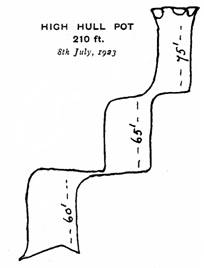Cave Exploration
I. – New Discoveries.
Ingleborough, Diccan Pot – In the night of 7th July, 1923, as described in this number, W. V. Brown, J. Hilton, and E. E. Roberts made the second descent of the mighty underground shaft by which the Long Churn water pursues its course towards the bottom of Alum Pot.
In making the first exploration beyond the foot of this 120-foot shaft, they descended rapidly in a narrow and lofty rift by means of three single ladder pitches, and reached a point at the head of the final waterfall, about 250 feet below the entrance, one man being lowered another 30 feet.
Newby Moss -In the autumn of 1922, members of the Gritstone Club descended all the shafts of Pillar Pots I., II. and III., which reach to the same chamber. They also descended Long Kin West and all the other pot-holes of the group, including three which they dug out, Star Pot (90 feet), Boggart’s Roaring Hole II. (120 feet), and one marked at present as Y Pot (45 feet)
Fountains Fell, Gingling Pot.- On 22nd July, 1923, W. V. Brown, J.Hilton, and E. E. Roberts penetrated a considerable distance into this hitherto unexplored cave.
It is the last well-known pot-hole to sustain serious attack and proves to be of a different type. The party was not strong enough in numbers to push on with ladders &c. along the extremely narrow passage, and stopped after accounting for three pitches.
Mallerstang – The mysterious rumours which have been current for some years of the existence of pot-holes N. of Hawes junction, were given reality by the discovery in the last days of 1922 of the Angerholm Pots on Wild Boar Fell. Two expeditions, by J. H. Buckley, J. Buckley, Devenish and E. E. Roberts in March, and by Ellis and Roberts in June, have since accounted for 11 pot-holes in the Angerholm group which require a ladder and for half a dozen elsewhere.
The limestone beds are thin, but the district is an interesting one to explore, and it is clear there are still many more shafts to be found of depths up to 40 feet.
Penyghent, High Hull Pot – Members of the Gritstone Club 210 made the first descent on 8th July, 1923, after diverting the beck and making a partial descent the week-end before. There are three vertical ladder pitches into three chambers, almost on top of one another and running to the south. The floor of the first, 75 feet deep, forms a fine circular bowl, with the water flowing out of the S.W. corner down a narrow opening, to fall 65 feet into a roomy chamber. Here a bedding plane enlarges into a drain pipe, which opens in a few yards into a huge chamber 60 feet deep. The ladder being 10 feet short, Mr. H. C. Wood had to drop off on to the piled-up scree. The end, reached in a fissure going S., was about 210 feet below the entrance. High Hull Pot is a splendid place to visit.
II. – Other Expeditions.
Penyghent, Little Hull Hole – In July, 1923, the Gritstone Club descended the two big shafts which follow the top passage. One man reached the head of the third pitch at the end of the straight and narrow lower fissure passage, and another was hung up at the worst point. They agree that the Y.R.C. explorers have not exaggerated the trials they went through.
Gragreth End, Marble Steps Pot – H. Humphreys, A. Humphreys and Blackburn Holden, with several friends, made a further exploration of Marble Steps Pot, Easter, 1923.
At the top of the scree slope in the big chamber, a passage was found on the right-hand side by means of which the party were enabled to reach the bottom, obviating a 50-foot ladder pitch necessary for the direct descent. [The small stream passage about 40 yards higher up the watercourse from the main hole was thoroughly examined. This passage opens out into the big chamber near the roof. A 50-foot ladder and about 30 feet of climbing bring one to the top of the 50-foot pitch at the bottom of the scree slope.] The far passage beyond the big chamber was followed until it narrowed to a tight squeeze; a light lowered in one of the most difficult places showed a large passage or chamber at a lower level. Further exploration may find means of access to this place – H.H.
Wharfedale, Hell Hole or Trollers Hole – A descent was made in April, 1923, by three Y.R.C. men. No difficulty was found in passing the rolled-up ladders through the “Fat Man’s Agony” and the tunnel beyond.
Nidderdale, Manchester Hole – A visit in December, 1922, led to the following notes, which add something to Cuttriss’s description. A wide high passage leads downstream a long way. In one place, behind a curtain of stalactites, you look up a steep mud slope. When the passage narrows, steep mud on the right can be ascended to the area described by Cuttriss as 100 feet by 40 feet, whence it is possible to reach the stream again. It was found possible, however, and much shorter in time to follow the water through two low tunnels into good going. These seem to have been cleared of mud since October, 1921. After a sharp right turn in a deep pool, the roof descends, but a 15-foot crawl takes one into a high narrow fissure, with its sides eroded into “rags”. The cave very soon ceases at a wide pool with a flat roof sloping into it. It may have been many years since this point was last reached.
Goyden Pot – We learn that the Labyrinth described in the last number was entered and partly explored in 1896 by Booth and Cuttriss. This disposes of the idea that about that time the entrance was blocked with silt.
